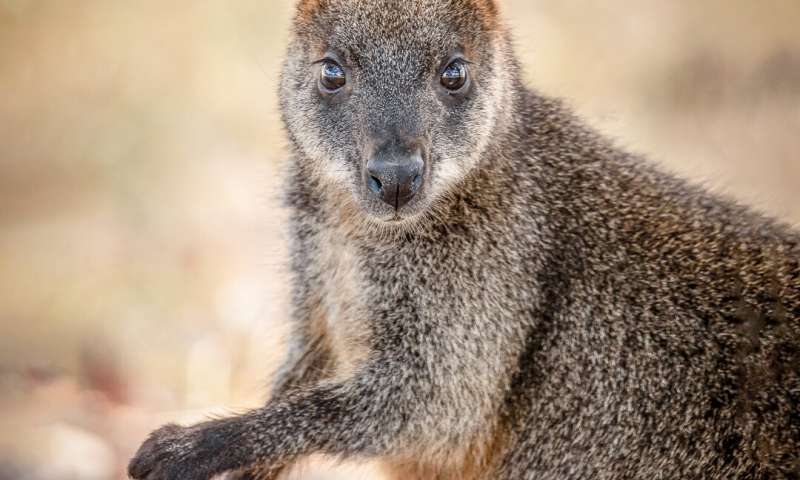Swamp wallabies conceive new embryo before birth—a unique reproductive strategy

Marsupials such as kangaroos or wallabies are known for their very different reproductive strategies compared to other mammals. They give birth to their young at a very early stage and significant development occurs during a lengthy lactation period in which the offspring spends most of its time in a pouch. Although in some marsupials new ovulation happens only a few hours after giving birth, the regular consecutive stages of ovulation, fertilization, pregnancy and lactation are respected—with one exception: Reproduction specialists from the Leibniz Institute for Zoo and Wildlife Research (Leibniz-IZW), Germany, and the University of Melbourne, Australia, recently demonstrated that swamp wallabies ovulate, mate and form a new embryo before the birth of the previous offspring. They thereby continuously support embryos and young at different development stages before and after birth. These findings are published in the Proceedings of the National Academy of Sciences.
Using high-resolution ultrasound to monitor reproduction in swamp wallabies during pregnancy, Prof Thomas Hildebrandt (Leibniz-IZW and University of Melbourne), Dr. Brandon Menzies and Prof Marilyn Renfree (both from University of Melbourne) were able to confirm what has been suspected for a long time: swamp wallaby females ovulate, mate and form a new embryo whilst already carrying a full-term fetus that they will soon give birth to. The new embryo enters embryonic diapause until the new-born offspring leaves the pouch nine months later. Thus, when the embryonic diapause is included, females are continuously pregnant throughout their reproductive life, a unique reproductive strategy that completely blurs the normal staged system of reproduction in mammals.
This phenomenon is made possible by two anatomically completely separated uteri and cervices connected to ovaries by their oviducts. "This is true for all marsupials, but the unique overlapping reproductive cycles seem to be a special feature of the swamp wallabies," says Renfree. Normally, ovulation alternates between the two ovaries. "All female macropodid marsupials—essentially kangaroos, wallabies and a few other groups of species—except the swamp wallaby have an oestrous cycle longer than the duration of their pregnancy, so females come into oestrus, ovulate and mate within hours after birth." It has been suspected for some time that swamp wallabies might conceive during an active pregnancy, because the oestrous cycle of the swamp wallaby is shorter than the duration of their pregnancy and there have been reports about mating before the birth of the previous offspring. Such a "superfetation" has previously been only described (by Leibniz-IZW scientists) for the European brown hare where females copulate again three to four days before the birth of the incumbent young, forming new conceptuses during an active pregnancy.
In order to confirm superfetation in swamp wallabies, the scientists removed the pouch young of ten females to reactivate the dormant blastocysts (early stage embryo). They then monitored the development of the blastocyst in four of these ten females using high-resolution ultrasound. All females gave birth at around 30 days after the young had been removed. Parallel to the embryo development in one uterus, the scientists closely examined the opposite ovary. There, follicles started to appear and grow. At day 26 of the pregnancy the ultrasound examination showed that the conceptus had developed into a fetus with the head, limbs and heartbeat clearly visible—and at day 28 and 29 the largest follicle in the opposite (contralateral) ovary had ovulated and a new corpus luteum was evident. The other six females that were not scanned with ultrasound were regularly examined for sperm. Sperm was identified in the urogenital tract one to two days before birth but at no other time. "These results clearly demonstrate that swamp wallabies ovulate and mate one to two days before birth, during an existing pregnancy," says Hildebrandt.
Pregnancies of eutherian mammals (most mammals, i.e. the most taxonomically diverse of the three branches of mammals) greatly exceed the length of the oestrous cycle, so during mammalian evolution, there has been selection pressure to extend the duration of pregnancy. Among marsupials (who form a second taxonomic branch of mammals), gestation in most macropodids encompasses almost the entire duration of the oestrous cycle. The swamp wallaby takes this one step further with its pre-partum oestrus, allowing this marsupial's gestation length to exceed the oestrous cycle length.
Sadly, many of these unique animals have been lost in the current disastrous bushfires in Australia this summer.
More information: Brandon R. Menzies el al., "Unique reproductive strategy in the swamp wallaby," PNAS (2020). www.pnas.org/cgi/doi/10.1073/pnas.1922678117
No comments:
Post a Comment